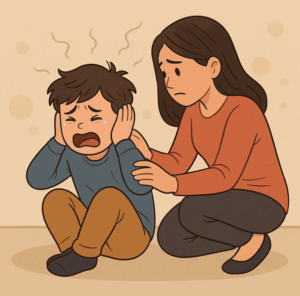Managing Sensory Meltdowns in Autism: What Works and What Doesn’t
 😡 What Is a Sensory Meltdown?
😡 What Is a Sensory Meltdown?
A sensory meltdown is not a tantrum. It’s a neurological response to overwhelming sensory input—light, sound, smell, touch, or crowds.
Unlike tantrums (which are goal-directed), meltdowns are involuntary. The child is not trying to manipulate or misbehave—they are trying to survive the sensory overload.
“He screams, cries, hits himself… then suddenly falls asleep.”
“She’s inconsolable after visiting the mall or marriage function.”
These are classic post-meltdown patterns.
🧠 What Causes Meltdowns?
-
Loud noises (fireworks, honking, vacuum)
-
Bright or flickering lights
-
Scratchy clothes or tight socks
-
Crowded public places
-
Transitions and unpredictability
-
Sudden changes in routine
-
Hunger, tiredness, or discomfort
Think of it as the brain’s emergency shutdown—like a circuit breaker tripping due to overload.
🔍 Signs of an Impending Meltdown
-
Covering ears or eyes
-
Pacing or fleeing the scene
-
Restlessness or hand-flapping intensifying
-
Verbal distress: “Stop!” “Too much!”
-
Withdrawal or going completely silent
If spotted early, you can often prevent the meltdown.
🛠️ What Actually Helps During a Meltdown?
✅ DO:
-
Stay calm – Your regulation supports theirs
-
Move to a low-stimulation environment – Quiet, dim, familiar
-
Use minimal language – “You’re safe. I’m here.”
-
Apply deep pressure (only if the child likes it) – Hug, weighted blanket, firm touch
-
Allow stimming – Rocking, flapping, humming can self-soothe
-
Offer noise-canceling headphones or sunglasses if tolerated
-
Let the child recover at their pace – Don’t rush or scold
🚫 What to Avoid
-
Yelling, scolding, or threatening
-
Trying to reason during meltdown – Logic won’t work in fight-or-flight mode
-
Touching without consent – May worsen the distress
-
Punishing the behavior – It’s not voluntary
-
Crowding or restraining unless there’s risk of harm
🧩 Long-Term Strategies to Reduce Meltdowns
-
Occupational Therapy with Sensory Integration
-
Sensory diet tailored to your child’s needs (brushing, jumping, swinging)
-
Use of visual schedules and transitions
-
Social stories to prepare for new experiences
-
Predictable routines and calming corners at school/home
-
Build emotional vocabulary (“I feel hot… too loud… tired… confused”)
-
Teach coping skills when calm, not during crisis
💬 Real-Life Example
Shravan, age 7, had meltdowns every time the family went shopping. Through OT-based sensory integration, structured pre-outing routines, and use of noise-canceling headphones, he now manages 30–45 minutes at the supermarket calmly.
📍 Dr. Srinivas Rajkumar T
Consultant Psychiatrist – Child, Adolescent & Geriatric Psychiatry
Apollo Clinics Velachery & Tambaram | Mind & Memory Lab
🌐 www.srinivasaiims.com | 📞 +91 85951 55808
Helping families manage sensory processing issues, meltdowns, and emotional regulation through compassionate, neurodiversity-affirming care.